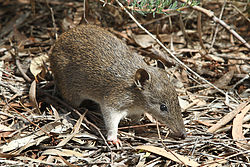| Short-nosed bandicoots [1] | |
|---|---|
 | |
| Southern brown bandicoot Isoodon obesulus | |
| Scientific classification | |
| Kingdom: | Animalia |
| Phylum: | Chordata |
| Class: | Mammalia |
| Infraclass: | Marsupialia |
| Order: | Peramelemorphia |
| Family: | Peramelidae |
| Subfamily: | Peramelinae |
| Genus: | Isoodon (Desmarest, 1817) |
| Type species | |
| Didelphis obesula Shaw, 1797 | |
| Species & subspecies | |
The short-nosed bandicoots (genus Isoodon) are members of the order Peramelemorphia. These marsupials can be found across Australia, although their distribution can be patchy.[ citation needed ] Genetic evidence suggests that short-nosed bandicoots diverged from the related long-nosed species around eight million years ago, during the Miocene epoch, and underwent a rapid diversification around three million years ago, during the late Pliocene. [2]